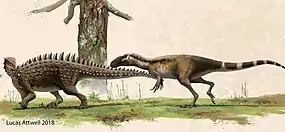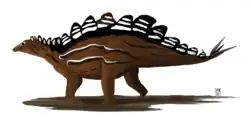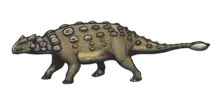Emausaurus
Emausaurus is a genus of thyreophoran or armored dinosaur from the Early Jurassic (Toarcian). Its fossils have been found in Mecklenburg-Vorpommern, northern Germany. Emausaurus is the only known Toarcian thyreorphoran and it is also the only dinosaur from the Ciechocinek Formation with a formal name.[1]
| Emausaurus | |
|---|---|
 | |
| Restoration of Emausaurus being attacked by an unnamed theropod belonging to the Orionides | |
| Scientific classification | |
| Kingdom: | Animalia |
| Phylum: | Chordata |
| Clade: | Dinosauria |
| Order: | †Ornithischia |
| Clade: | †Genasauria |
| Clade: | †Thyreophora |
| Genus: | †Emausaurus Haubold, 1990 |
| Species: | †E. ernsti |
| Binomial name | |
| †Emausaurus ernsti Haubold, 1990 | |
Discovery and naming
The type and only species, E. ernsti, was named and described by Harmut Haubold in 1990.[2][1] The generic name is composed of an acronym of Ernst Moritz Arndt University of Greifswald and Greek sauros/σαυρος (lizard). The specific name is derived from the name of geologist Werner Ernst, who acquired the fossil, holotype SGWG 85, in the summer of 1963 from foreman Werner Wollin at a loampit near Grimmen, in strata dating from the Toarcian.[1][3][4] It is known by the right side of the skull, the right lower jaw, caudal vertebrae, neural arches, a radius, a metatarsal, a claw, fragments of ribs, scutes and plates, known as EMAU SGWG 85.[1][5]
Description
Emausaurus was probably a semibipedal to quadrupedal animal, being covered on a armor of osteoderms across the body. Like other thyreorphora, probably was hervivore, concretely a low dwelling one, with a diet more related with ground flora, such as Cycads and Bennnetitales.[1] The body length of the holotype of Emausaurus has been estimated at around 2.5 m, with a weight of 70-90 kg.[1] This was based on a juvenile individual though; adult length has been estimated at three to four metres, with a weight up to 240 kg.[1] Most of the reconstruction has been based on Scelidosaurus, although it is possible that Emausaurus was a more bipedal animal, as some of the young specimens of Scelidosaurus were thought to be. Adult forms probably where more quadrupedal.[6] Armor includes three conical scutes and one tall, spiny element.[7] David Norman in 2019 examined the morphology of Scelidosaurus, comparing it with Emausaurus. In Emausaurus the maxilla has, overall, a similar morphology to that seen in Scelidosaurus. The disarticulated maxilla of Emausaurus exhibits an anteromedially directed robust process with which it met its counterpart in the midline, creating a wedge-like structure, with no obvious offset between the alveolar margins. In Emausaurus the structure of the frontals is not well preserved. In outline, its proportions resemble those of Scelidosaurus, but the same is true of many Ornithischia. The lacrimal bone of Emausaurus is incomplete, but includes a long, curved jugal process that evidently wrapped itself around the anterior tip of the jugal.[8] So little is known of the postcranium Emausaurus, recovering parts like a multipartite odontoid (sutured to the axis centrum), similar to that of Scelidosaurus.[9] Emausaurus has a series of assigned Osteoderms, but lacks like Scutellosaurus ‘scapular osteoderms’. The major series of osteoderms foun appear to come from the tail or the dorsal section.[10]
Classification
Cladistic analyses showed that Emausaurus was a basal member of the Thyreophora, more derived than Scutellosaurus, but less than Scelidosaurus.[11] Scelidosaurus, Emausaurus and Scutellosaurus cluster at the base of most trees because they can be scored for only a restricted number of anatomical characters.[12][13] The cladistic status of the specimen is relatively controversial due to its young nature. Clearly it is a member of the Thyreophora, but its position can change by the time, if an adult specimen is found.[14] Emausaurus can be more derived than Scelidosaurus, or even be a sister taxon to Stegosauria.[15] The major consensus has put Emausaurus as a non-eurypodan stem thyreophoran, along with Scutellosaurus and Scelidosaurus reinforced by almost all subsequent systematic reviews of ornithischian–thyreophoran relationships.[16][17] Being Emausaurus and Scutellosaurus more basal than Scelidosaurus.[17] Emausaurus has been put on an outgroup to Ankylosauria, with Scelidosaurus and the basal stegosaur Huayangosaurus.[18] 7. Vickaryous et al. (2004), did the default phylogenetic analysis for ingroup ankylosaurs, due to including cranial and postcranial characters, a wide range of taxa and made no in-group relationships, although this analysis used the holotype Lesothosaurus and Huayangosaurus as outgroups, ignoring Scelidosaurus and Emausaurus.[19] On 2020, Norman et al. by studying Scelidosaurus found that along Scutellosaurus and Emausaurus both are positioned on the stem of Ankylosauria, rather than on the stem of Thyreophora, with Emausaurus as the basal sister-taxon to Scelidosaurus.[20] This is because Emausaurus possesses a dorsal margin of the dentary sinuous in lateral view and neither elongated nor squat proportions of metacarpal 1 ‘medium’.[20] Alternatively, Emausaurus can be basal sister-taxon to Scutellosaurus, but taking the similarities between Emausaurus and Scelidosaurus is more unlikely.[20] The Norman study is resumed on:
| Thyreophora |
| ||||||||||||||||||||||||||||||
Paleoecology
Emausaurus has a sinuous jaw profile, more advanced in ankylosauromorphans, unlike the rectilinear morphology seen in the more basal genus Scutellosaurus.[20] The changes on the jaw is considered a series of modifications due to changes on the Diet and evolution of the food procesation of this dinosaurs, where it seems to be adapted to eat Coriaceous flora, such as Bennetites and Cycads, abundant on the Ciechocinek Formation Lublin Coal Basin.[21] The rest of the skeleton of this genus is poorly presented, with for example the vertebrae showing no evidence of the proportional changes in the height of the neural arches and spines seen on stegosaurs.[20] The animal was covered on Osteoderms, altrougth the few found give no indication of how extensively they were distributed across the torso.[20] Emausaurus, based on the proportions of the preserved metacarpals that the forelimb shows adaptations for weight support, rather than grasping, having ungulal phalanges that are conical and only slightly decurved.[20] The partial known proximal pedal phalanges are short and block-like, with near the same proportions seen in the pes of Scelidosaurus.[20] A series of characters that together are suggestive of graviportality and quadrupedality, maling Emausaurus a low roaming herbivore. Pseudo-Bipedality isn't discarded, with the genus able to reach slightly taller flora.[20]
Paleoenvironment
The holotype of Emausaurus was found on the so-called "Emausaurus type site", from the Ciechocinek Formation dating from the Lower Toarcian (Tenuicostatum).[22] Is is a boundary composed by bituminous shale,[2] that represents an ancient seashore environment, probably lagoonal, and it is contemporaneous of the Posidonia Shale of Southern Germany. Fossil wood has been found on the same location, including driftwood and other related to the Araucariaceae, present in other European environments of Toarcian age.[2] Of the invertebrate fauna insects, bivalves, sea snails and ammonites (Genus Tiltoniceras, Eleganticeras and Lobolytoceras) have been found.[2] The vertebrate fauna is also varied, with fossils of the fish genus Saurorhynchus,[23] and the new genus Grimmenichthys[24] and Grimmenodon.[25] Reptile fossils include Ichthyosauria indet., indeterminate Plesiosauria, rhomaleosaurid plesiosaurs, indeterminate Mesoeucrocodylia (probably Goniopholididae), indeterminate Thalattosuchia[26] and at least two gravisaurian sauropods.[27]
References
- Haubold, H. (1991). Der Greifswalder Dinosaurier ‘‘Emausaurus’’. Fundgrube, 27(2), 51-60.
- Haubold, H. 1990. Ein neuer Dinosaurier (Ornithischia, Thyreophora) aus dem Unteren Jura des nördlichen Mitteleuropa. Revue de Paleobiologie 9(1):149-177. [In German]
- Pereda-Suberbiola, X., Díaz-Martínez, I., Salgado, L., & de Valais, S. (2015). Síntesis del registro fósil de dinosaurios tireóforos en Gondwana. Publicación Electrónica de la Asociación Paleontológica Argentina, 15(1).
- Martill, D. M., Batten, D. J., & Loydell, D. K. (2000). A new specimen of the thyreophoran dinosaur cf. Scelidosaurus with soft tissue preservation. Palaeontology, 43(3), 549-559.
- http://www.paleofile.com/Dinosaurs/Armor/Emausaurus.asp
- Probst, E. (2010). Dinosaurier in Deutschland: von Compsognathus bis zu Stenopelix. GRIN Verlag.
- Norman, D.B.; Witmer, L.M. & Weishampel, D.B. (2004). "Basal Thyreophora". In Weishampel, D.B.; Dodson, P. & Osmólska, H. (eds.). The Dinosauria, 2nd Edition. University of Californian Press. pp. 335–342. ISBN 0-520-24209-2.
- Norman, D. B. (2019). Scelidosaurus harrisonii from the Early Jurassic of Dorset, England: cranial anatomy. Zoological Journal of the Linnean Society. doi:10.1093/zoolinnean/zlz074
- Norman, D. B. (2019). Scelidosaurus harrisonii from the Early Jurassic of Dorset, England: postcranial skeleton. Zoological Journal of the Linnean Society. doi:10.1093/zoolinnean/zlz078
- Norman, D. B. (2020). Scelidosaurus harrisonii from the Early Jurassic of Dorset, England: the dermal skeleton. Zoological Journal of the Linnean Society. doi:10.1093/zoolinnean/zlz085
- Sereno, P. C. (1997). The origin and evolution of dinosaurs. Annual Review of Earth and Planetary Sciences, 25(1), 435-489.
- Sereno PC. 1999. The evolution of dinosaurs. Science 284: 2137–2147
- Butler RJ, Upchurch P, Norman DB. 2008. The phylogeny of the ornithischian dinosaurs. Journal of Systematic Palaeontology 6: 1–40.
- Porro, L. B., Witmer, L. M., & Barrett, P. M. (2015). Digital preparation and osteology of the skull of Lesothosaurus diagnosticus (Ornithischia: Dinosauria). PeerJ, 3, e1494.
- Stumpf, S., & Meng, S. (2013). Dinosaurier aus Nordostdeutschland: Verschleppt. Biologie in unserer Zeit, 43(6), 362-368.
- Coombs WP, Maryańska T. 1990. Ankylosauria. In: Weishampel DB, Dodson P, Osmólska H, eds. The Dinosauria. Berkeley: University of California Press, 456–483.
- Arbour VM, Currie PJ. 2016. Systematics, phylogeny and palaeobiogeography of the ankylosaurid dinosaurs. Journal of Systematic Palaeontology 14: 385–444.
- Hill RV, Witmer LM, Norell MA. 2003. A new specimen of Pinacosaurus grangeri (Dinosauria: Ornithischia) from the Late Cretaceous of Mongolia: ontogeny and phylogeny of ankylosaurs. American Museum Novitates 3395: 1–29
- Vickaryous MK, Maryańska T, Weishampel DB. 2004. Ankylosauria. In: Weishampel DB, Dodson P, Osmólska H, eds. The Dinosauria, 2nd edn. Berkeley: University of California Press, 363–392.
- Norman, D. B. (2020). Scelidosaurus harrisonii (Dinosauria: Ornithischia) from the Early Jurassic of Dorset, England: biology and phylogenetic relationships. Zoological Journal of the Linnean Society. doi:10.1093/zoolinnean/zlaa061
- Szydeł, Z., & Szydeł, R. (1981). Profil utworów liasu na obszarze Lubelskiego Zagłębia Węglowego. Przegląd Geologiczny, 29(11), 568-571.
- Ernst, W. E. R. N. E. R. (1967). Die Liastongrube Grimmen. Sediment, Makrofauna und Stratigraphie. Ein Überblick. Geologie, 16, 550-569.
- E. E. Maxwell and S. Stumpf. 2017. Revision of Saurorhynchus (Actinopterygii: Saurichthyidae) from the Early Jurassic of England and Germany. European Journal of Taxonomy 321:1-29
- M. Konwert and M. Hörnig. 2018. Grimmenichthys ansorgei, gen. et sp. nov. (Teleostei, 'Pholidophoriformes'), and other 'pholidophoriform' fishes from the early Toarcian of Grimmen (Mecklenburg-Western Pomerania, Germany). Journal of Vertebrate Paleontology 38:e1451871
- S. Stumpf, J. Ansorge, C. Pfaff and J. Kriwet. 2017. Early Jurassic diversification of pycnodontiform fishes (Actinopterygii, Neopterygii) after the end-Triassic extinction event: evidence from a new genus and species, Grimmenodon aureum. Journal of Vertebrate Paleontology 37:e1344679
- Stumpf, S. (2017). A Synoptic Review of the Vertebrate Fauna from the "Green Series" (Toarcian) of Northeastern Germany with Descriptions of New Taxa: A Contribution to the Knowledge of Early Jurassic Vertebrate Palaeobiodiversity Patterns (Doctoral dissertation, Mathematisch-Naturwissenschaftliche Fakultät der Ernst-Moritz-Arndt-Universität Greifswald).
- S. Stumpf, J. Ansorge, and W. Krempien. 2015. Gravisaurian sauropod remains from the marine late Early Jurassic (Lower Toarcian) of North-Eastern Germany.
External links

